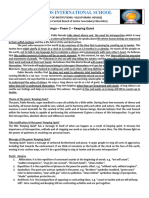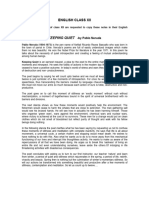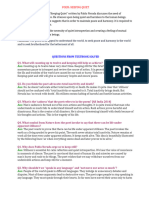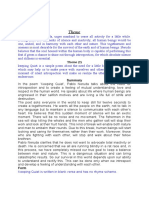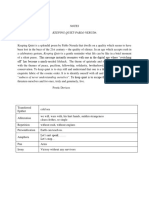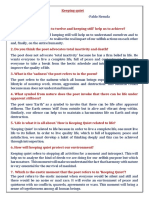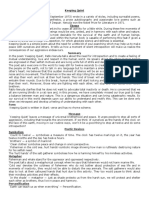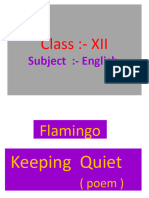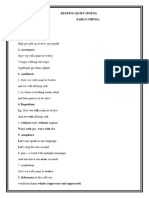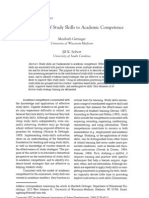English
English
Uploaded by
mairamansur452Copyright:
Available Formats
English
English
Uploaded by
mairamansur452Original Title
Copyright
Available Formats
Share this document
Did you find this document useful?
Is this content inappropriate?
Copyright:
Available Formats
English
English
Uploaded by
mairamansur452Copyright:
Available Formats
M.E.
S INDIAN SCHOOL
ABU HAMOUR BRANCH, DOHA – QATAR
NOTES [2023-2024]
Class & Div.: XII (All Divisions) Subject: English
Lesson/Topic: Keeping Quiet Date: 04/05/2023
xxxxxxxxxxxxxxxxxxxxxxxxxxxxxxxxxxxxxxxxxxxxxxxxxxxxxxxxxxxxxxxxxxxxxxxxxxxxxxxxxxxxxxxxxxxxxxxxxxxxxxxxxxxxx
Ref. No. ENG-N-12
GLOSSARY
Still = quiet and motionless
Face = surface
Exotic = unusual and exciting
Rush = hurry
Engines = machines
Strangeness = something unusual or surprising
Cold sea = sea near the polar regions
Green wars = wars against nature or environment
Survivors = people left alive after a war
In the shade = under the trees
Confused = misunderstood
Inactivity = not doing anything
Want no truck with = refuse to deal with
Interrupt = stops or disturb
Threatening = endangering, causing trouble or threat
Count to twelve = Counting has been considered as an act of calming down by psychiatry
The face of Earth = The entire world without any exceptions
Sudden Strangeness = Absolute calm is something which is hardly practiced by us. The act of
‘keeping quiet’ all at once, is bound to fill us with a sense of
unfamiliarity since it a practice so alien to humans who always feel the
need to be in some activity, as professed by the poet in the poem
eventually
Hurt Hands = Taxing manual labor such as gathering salt has a corroding effect on the hands
Green Wars = Wars on Nature
Gas = Reference to gas bombs
Clean clothes = note of anti-violence struck by the poet through this phrase
Total inactivity = Dormancy
Want no truck with death = The poet does not want the readers to misunderstand the
stillness - that he recommends for death
ACD-105, REV 0, 27.03.2021
Single minded = Narrow in thoughts, having a lack of a vision while thinking
Sadness of never understanding ourselves = the feeling of discontent emerging from being
unaware of our mental composition, capabilities
and all our desires
BACKGROUND
Keeping Quiet dwells on quality of silence which seems to have been lost in the buzz of 21st
century. In an age which accepts rush in a celebratory gesture, Keeping Quiet is a gentle
reminder what life can be like in a brief moment of a silent pause. This message instantly
resonates in the digital age where “switching off” has become a much needed life-hack. The
theme of quietude and stillness is accompanied with the themes of peace, pacifism,
fellowship, solidarity, brotherhood, justice and ecological conservation. To keep quiet is stay
still and understand that one is a thread, woven within the cosmic order. It is to identify
oneself with all and for once, truly and genuinely, live.
FORM
Keeping Quiet is written in blank verse and has no rhyme scheme.
INTRODUCTION
The poem “Keeping Quiet” written by Pablo Neruda discusses the need of maintaining peace
and silence. He stresses upon being quiet and harmless to the human beings, animals and
environment. He suggests that in order to maintain peace and harmony, it is required to stop
and introspect ourselves.
ABOUT THE AUTHOR
Pablo Neruda (1904 – 1973) was the ‘pen name’ of Neftali Ricardo Reyes Basoalto and later,
‘legal name’ of this famous Chilean poet- diplomat- politician. He won the Noble prize for
literature in the year 1971. He wrote in green ink which was his personal symbol for desire
and hope. His writings are simple, wherein lies their beauty.
Originally written in Spanish, the essence of this poem is based on introspection and
retrospection. The poet feels that some soul-searching is needed for us to be at peace with
ourselves and others.
MAIN POINTS
1. The poem talks about the necessity of quiet introspection.
2. It will help people to understand themselves & will create the feeling of mutual love &
relationship.
3. By quiet introspection, the poet doesn’t mean total inactivity; instead he wants full
involvement with life.
4. The reason for the discard & war is the imbalance between man & nature.
ACD-105, REV 0, 27.03.2021
5. Quiet introspection will establish a spiritual & physical union that is most desirable for the
survival of the earth & of human beings.
THEME-1
The poet, Pablo Neruda, urges mankind to cease all activity for a little while. During these
few moments of silence and inactivity, all human beings would be one, united, and in
harmony with each other and nature. This togetherness and oneness is most desirable for
the survival of the earth and of human beings. Neruda believes that the soul housed within
the human body is capable of performing this feat if given a chance to shine out through
introspection, for which absolute silence and stillness is essential.
THEME-2
Keeping Quiet is a simple poem about the need for a little bit of soul-searching which may
help us to make peace with ourselves and others. It tells us how a moment of silent
introspection will make us realize the utter of our aggressive endeavors.
MESSAGE / CENTRAL IDEA
`Keeping Quiet’ leaves a message of universal brotherhood and peace. It urges people to stop
all sorts of aggression, including that towards the environment. If we think of ourselves as the
hands of the clock on the face of this earth, moving in our routine ways, won’t it be a good
thing to stop at twelve and do some introspection?
JUSTIFICATION OF THE TITLE
The title of the poem suggests that we must keep quiet for a moment. There will be silence
and all will set together and realize the value of collectiveness. Here, we should not confuse
‘stillness' with 'total inactivity’. Life should go on as it is doing about. Even the nature remains
at work and keeps the earth alive which remains busy in doing some activity. The poem
stresses the significance of mutual understanding and necessity for introspection. Thus the
title is quite appropriate.
POETIC DEVICES
• Alliteration = We will (line 1 and 2); Once on; we would; Sudden strangeness; his hurt
hands; wars with; clean clothes; we were; so single-minded;
• Pun = Meaning 1- ‘hands’ meaning 2- ‘weapons’
• Repetition = Without .... without; wars with …. wars with;
• Symbolism = Cold sea – symbolised as polar region
• Enjambment = and for once could perhaps a huge silence …. of threatening ourselves
with death.
• Antithesis = Count ................still; Dead …. Alive;
ACD-105, REV 0, 27.03.2021
• Assonance = use of vowel ‘o’ (victory with no survivors, would put on clean clothes
and walk about with their brothers); Use of vowel sound ‘o’ and ‘e’ (Now we will count
to twelve, not move our arms so much)
• Anaphora: Two consecutive lines starting with the word ‘Let’s’
let’s not speak in any language,
let’s stop for one second,
THINK IT OUT
Q1. What will counting up to twelve and keeping still help us achieve?
Ans: Counting up to twelve takes very short time. Keeping still for this brief interval of time
gives us a momentary pause to introspect and review the course of action. It is generally
observed that most of the ills and troubles of the world are caused by our rush or hurry.
Violence is caused by anger. Keeping quiet and still will give us necessary respite and ensure
peace.
Q2. Do you think the poet advocates total inactivity and death?
Ans: No, he doesn’t advocate either total inactivity or death. He makes it quite clear that
‘stillness’ should not be confused with “total inactivity or equated to it. Total inactivity brings
death. But Neruda has ‘no truck with death’. His stillness means halting of harmful and
hostile human activities.
Q3. What is the ‘sadness’ that the poet refers to in the poem?
Ans: Man’s sadness is formed out of his own actions and thoughts. It is quite ironical that
man who understands so much fails to understand himself and his action. Rash actions prove
harmful and disastrous. Man is the creator of all disasters. He is always threatening himself
with death because of his thoughts and actions. This is the tragedy of his life.
Q4. What symbol from Nature does the poet invoke to say that there can be life under
apparent stillness?
Ans: The poet wants to prove that there can be life under apparent stillness. The poet
invokes the earth as a living symbol to prove his point. The earth never attains total inactivity.
Nature remains at work all the time even under apparent stillness. It keeps earth alive. This
idea is beautifully illustrated by the following lines: “as when everything seems dead and
later proves to be alive.”
***************
ACD-105, REV 0, 27.03.2021
You might also like
- Sample Report For CFA in APADocument6 pagesSample Report For CFA in APANasir Jan Kakar100% (1)
- Textbook Checkpoint Complete Biology Cambridge Secondary 1Document260 pagesTextbook Checkpoint Complete Biology Cambridge Secondary 1Vrushali Sukhi100% (7)
- Revocation of Gift (Hiba)Document13 pagesRevocation of Gift (Hiba)legalight100% (2)
- keeping quietDocument5 pageskeeping quietkaran bhamreNo ratings yet
- Grade XII English Poem 2 Keeping QuietDocument4 pagesGrade XII English Poem 2 Keeping Quietshipra bataviaNo ratings yet
- Keeping Quiete EngDocument5 pagesKeeping Quiete EngVipul PASINo ratings yet
- Keeping QuietDocument2 pagesKeeping Quietv68whrmhwbNo ratings yet
- Keeping QuietDocument10 pagesKeeping Quietgotostudyash2007No ratings yet
- Keeping QuietDocument2 pagesKeeping QuietA mere potatoNo ratings yet
- Keeping QuietDocument2 pagesKeeping QuietVyshnavi T MNo ratings yet
- Q&ADocument2 pagesQ&AvsalamandenialNo ratings yet
- Keeping QuietDocument1 pageKeeping QuietafzqawqxzwrflqNo ratings yet
- Keeping Quiet NotesDocument4 pagesKeeping Quiet NotesMili Tandon100% (2)
- Notes Keeping Quiet Class 12Document2 pagesNotes Keeping Quiet Class 12Rashi LakhanpaulNo ratings yet
- EnglishProject 4Document20 pagesEnglishProject 4subikshanmugam21No ratings yet
- NOTES ON KEEPING QUIET, CLASS XIIDocument3 pagesNOTES ON KEEPING QUIET, CLASS XIIparewaaryanNo ratings yet
- Keeping QuietDocument20 pagesKeeping QuietmeowNo ratings yet
- Keeping QuietDocument37 pagesKeeping Quietfathimamuzammil111No ratings yet
- Keeping Quiet - NotesDocument5 pagesKeeping Quiet - NotesShahrukh AbediNo ratings yet
- Keeping QuitDocument8 pagesKeeping QuitBirender Singh100% (1)
- Keeping QueitDocument3 pagesKeeping Queitajoyeiy1No ratings yet
- P-1 STD 11Document3 pagesP-1 STD 11deepbag79No ratings yet
- Brown Vintage Background DocumentDocument10 pagesBrown Vintage Background Documentthisisamogh17No ratings yet
- Keeping Quiet by Pablo NerudaDocument4 pagesKeeping Quiet by Pablo NerudaVartak PadekarNo ratings yet
- STD 12 - Eng - Keeping Quiet - PPTsDocument48 pagesSTD 12 - Eng - Keeping Quiet - PPTsavni bhallaNo ratings yet
- G. D. Goenka Public School, Siliguri Class: Xii Subject: English (Prose)Document3 pagesG. D. Goenka Public School, Siliguri Class: Xii Subject: English (Prose)Yashu MaruNo ratings yet
- Keeping Quiet POETICDocument4 pagesKeeping Quiet POETICtarsembehal202No ratings yet
- Study Material - KEEPING QUIETDocument4 pagesStudy Material - KEEPING QUIETAakif RazaNo ratings yet
- Xii-Eng-Keeping Quiet-Poem Qa (Flamingo)Document6 pagesXii-Eng-Keeping Quiet-Poem Qa (Flamingo)Prince PandeyNo ratings yet
- KEEPING QUIETDocument5 pagesKEEPING QUIETsaraagrawal6819No ratings yet
- Keeping Quiet - Pablo NerudaDocument3 pagesKeeping Quiet - Pablo NerudaGracy amutharajNo ratings yet
- Keeping Quiet-1Document5 pagesKeeping Quiet-1bonheur3737No ratings yet
- Keeping Quiet NotesDocument3 pagesKeeping Quiet Notesanusha.gupta.0110No ratings yet
- Keeping Quiet: About The Poet - Pablo NerudaDocument15 pagesKeeping Quiet: About The Poet - Pablo NerudaOrion Bhak RancherNo ratings yet
- Poem-2, Keeping QuietDocument7 pagesPoem-2, Keeping QuietrajveersinghbagalNo ratings yet
- ENGLISH ALS PROJECT Class 12Document18 pagesENGLISH ALS PROJECT Class 12alvina75% (4)
- Notes Keeping quietDocument2 pagesNotes Keeping quietranveerjais27No ratings yet
- English Project (Edited)Document18 pagesEnglish Project (Edited)Nakshatra JonwarNo ratings yet
- CH-3 Keeping QuietDocument43 pagesCH-3 Keeping QuietNUTAN KUMARINo ratings yet
- Keeping QuietDocument2 pagesKeeping QuietLOGESH RAJANo ratings yet
- 9097023-Isn - 2017-18 - WS - Class Xii - English - Keeping QuietDocument3 pages9097023-Isn - 2017-18 - WS - Class Xii - English - Keeping Quietanamtakhan375No ratings yet
- Class:-XII: Subject: - EnglishDocument28 pagesClass:-XII: Subject: - EnglishPriyanka Guha Chowdhury100% (1)
- Keeping QuietDocument5 pagesKeeping QuietAnvi Sameer TiwariNo ratings yet
- Keeping Quiet Poem Notes Class 12Document10 pagesKeeping Quiet Poem Notes Class 12Disha Sethi100% (1)
- LR P 3 Keeping QuietDocument8 pagesLR P 3 Keeping QuietworkforadynamichamingNo ratings yet
- KEEPING QUIET (2)Document23 pagesKEEPING QUIET (2)ajayyymanoj2007No ratings yet
- Keeping QuietDocument3 pagesKeeping QuietpremiumuserqNo ratings yet
- READING MATERIALDocument3 pagesREADING MATERIALabhishekbinodnairNo ratings yet
- EnglishProject 1Document21 pagesEnglishProject 1subikshanmugam21100% (1)
- FinalDocument30 pagesFinalsumitchauhan100000No ratings yet
- KEEPING QUIET CWDocument2 pagesKEEPING QUIET CWmdivishithNo ratings yet
- Keeping QuietDocument2 pagesKeeping Quietap6733702No ratings yet
- Keeping QuietDocument4 pagesKeeping Quietakash6mugamNo ratings yet
- 12 - Poem - 2 - Keeping QuietDocument8 pages12 - Poem - 2 - Keeping QuietemshreeshivaniNo ratings yet
- Keeping QuietDocument3 pagesKeeping QuietNaynika MittalNo ratings yet
- Keeping Quiet English PresentationDocument15 pagesKeeping Quiet English PresentationKumar KartikeyNo ratings yet
- 12 English Flamingo Chapter -2 Keeping QuitDocument25 pages12 English Flamingo Chapter -2 Keeping Quityahiyama650No ratings yet
- Keeping Quiet - Resource Sourced From The WebDocument24 pagesKeeping Quiet - Resource Sourced From The WebAnahita MukherjeeNo ratings yet
- Keeping QuietDocument3 pagesKeeping QuietShivam SinghNo ratings yet
- Screenshot 2024-07-14 at 9.20.59 PM 2Document3 pagesScreenshot 2024-07-14 at 9.20.59 PM 2bnd.quest07No ratings yet
- Keeping QuietDocument4 pagesKeeping QuietDiksha VermaNo ratings yet
- Keeping Quiet-NotesghhhhggDocument2 pagesKeeping Quiet-Notesghhhhgghelllohey419No ratings yet
- Tardiness in Relation To The Academic PeDocument12 pagesTardiness in Relation To The Academic PeKunal Sajnani100% (1)
- MotivationDocument3 pagesMotivationZsheib BubNo ratings yet
- Mathematics P1 Feb-March 2014 Memo Afr & EngDocument17 pagesMathematics P1 Feb-March 2014 Memo Afr & Engaleck mthethwaNo ratings yet
- Technology of The FutureDocument2 pagesTechnology of The FutureЮлія ПерекопайNo ratings yet
- 2023年新课标全国Ⅰ卷英语真题(含听力)(解析版)Document24 pages2023年新课标全国Ⅰ卷英语真题(含听力)(解析版)zhimeiding315No ratings yet
- Thermo NotesDocument129 pagesThermo NotesManoj MallickNo ratings yet
- Instruct Contributions of Study Skills Gettinger 2002Document16 pagesInstruct Contributions of Study Skills Gettinger 2002Roslan Ahmad FuadNo ratings yet
- Manual Casio Module 3266 (EN)Document8 pagesManual Casio Module 3266 (EN)KAHNo ratings yet
- Worksheet - Grade 5 - Unit 3Document2 pagesWorksheet - Grade 5 - Unit 3Trinh AndreasNo ratings yet
- Advances in QRS Detection: Modified Wavelet Energy Gradient MethodDocument7 pagesAdvances in QRS Detection: Modified Wavelet Energy Gradient MethodInternational Journal of Emerging Trends in Signal Processing (IJETSP)No ratings yet
- The Fear BubbleDocument2 pagesThe Fear BubbleMichael CliftonNo ratings yet
- The Visible PC: Managing and Troubleshooting PcsDocument39 pagesThe Visible PC: Managing and Troubleshooting PcsMichael John PedrasaNo ratings yet
- Weapons and GearDocument8 pagesWeapons and GearIker Antolín Medina100% (1)
- Article by Bill RobinsonDocument25 pagesArticle by Bill RobinsonNeutronNo ratings yet
- EAPP - Module2.Quarter 1 - Week 3Document16 pagesEAPP - Module2.Quarter 1 - Week 3Jrick EscobarNo ratings yet
- Electrostatic GeneratorDocument56 pagesElectrostatic GeneratorPraveen KumarNo ratings yet
- Gramática Inglesa - O Guia Completo - Greyciele Almeida - Academia - EduDocument21 pagesGramática Inglesa - O Guia Completo - Greyciele Almeida - Academia - Edujulianomoura799No ratings yet
- Campus MapDocument1 pageCampus MapMohsin IqbalNo ratings yet
- Advanced Computer Architecture: Conditions of ParallelismDocument27 pagesAdvanced Computer Architecture: Conditions of ParallelismMaher Khalaf HussienNo ratings yet
- Dan A. Hays, A Senior Fellow at The Xerox Corporation's Wilson Center For Research and Technology, ExplainsDocument1 pageDan A. Hays, A Senior Fellow at The Xerox Corporation's Wilson Center For Research and Technology, ExplainsprakxajNo ratings yet
- Pde BookDocument295 pagesPde BookAshenafiNo ratings yet
- Verbal and Nonverbal Cues: - North America - South America - Russia - AustraliaDocument35 pagesVerbal and Nonverbal Cues: - North America - South America - Russia - AustraliaJulia MacugayNo ratings yet
- Fresh N' Famous Foods, Inc.Document2 pagesFresh N' Famous Foods, Inc.Cai PascualNo ratings yet
- Experimental Investigation On The Effect of Annealing On Fatigue Life of SAE 202 and 440C SteelsDocument5 pagesExperimental Investigation On The Effect of Annealing On Fatigue Life of SAE 202 and 440C Steelskelsiu1No ratings yet
- 1 CorrelationDocument1 page1 Correlationannabel.turner1412No ratings yet
- B9876 PDFDocument21 pagesB9876 PDF董庆庆No ratings yet
- MSA University - Maintenance Planning and Control Final Exam 2009Document3 pagesMSA University - Maintenance Planning and Control Final Exam 2009Good GuyNo ratings yet




